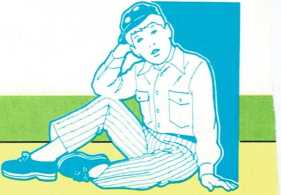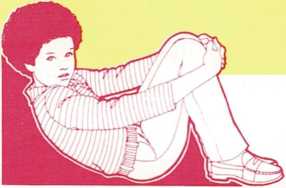Communicable Diseases
Communicable diseases. Most communicable diseases of childhood begin
in much the same way. A child may wake up in the morning with a
miserable case of sniffles, or may come dragging home from school,
aching and irritable. At this stage, there is a big question about what
the symptoms mean. It could be just a cold. But there is no question
about what you should do: ■ Put the child to bed and keep everybody else
out of the room.
Communicable diseases

+——————-+————–+———————————–+
| Disease | Incubation | Common symptoms |
| | period | |
+===================+==============+===================================+
| Chicken pox | 14 to 21 | Mild fever, headache, blisterlike |
| | days. | rash that appears suddenly. |
| (Varicella) | | Blisters become encrusted in 1 to |
| | | 3 days. |
+——————-+————–+———————————–+
| Diphtheria | 2 to 6 days; | Severe sore throat, fever, |
| | can range | yellowish-gray patches on |
| | from 1 to | tonsils, throat, or palate. |
| | | Breathing may become tight and |
| | 9 days. | difficult. |
+——————-+————–+———————————–+
| German | About 14 to | Sore throat and headache. Rash on |
| measles | 21 days. | face and head, spreading to neck |
| (Rubella) | | and trunk. Slight fever during |
| | | rash. Rash lasts 2 or 3 days. |
| | | Glands at back of head and neck |
| | | and behind ears become enlarged. |
+——————-+————–+———————————–+
| Influenza | 1 to 3 days. | Fever, chills, muscular aches and |
| | | pains. |
+——————-+————–+———————————–+
| Measles | Fever, 10 | Resembles cold. Fever, runny |
| | days after | nose, watery eyes, cough. White |
| (Rubeola) | exposure. | spots on inside of cheeks. Rash |
| | | begins near the ears and on the |
| | Rash, 14 | side of the neck and spreads |
| | days after | downward. |
| | exposure. | |
+——————-+————–+———————————–+
| Mumps | About 14 to | Fever, swelling, and pain in one |
| | 21 days | or more salivary glands. |
| (Infectious | (average, 18 | Difficulty in chewing and |
| parotitis) | days). | swallowing. |
+——————-+————–+———————————–+
| Poliomyelitis | 7 to 14 | Fever, sore throat, dull pain on |
| | days; can | bending neck, headache, muscle |
| (Infantile | range from 3 | spasms, stiff back. Symptoms may |
| paralysis) | to 35 days. | begin suddenly or gradually. |
+——————-+————–+———————————–+
| Scarlet fever | 2 to 5 days. | Begins very suddenly with |
| | | headache, chills, fever, sore |
| | | throat, vomiting. Neck glands |
| | | enlarged and tender. Tongue |
| | | coated and pitted looking at |
| | | first, then becomes red and |
| | | rough. Rash appears about 3 days |
| | | after first symptom. |
+——————-+————–+———————————–+
| Whooping | 5 to 21 days | Increased nose and throat |
| cough | (average, 10 | secretions. Spells of coughing, |
| (Pertussis) | days). | which are worse at night. Slight |
| | | fever. Whooping develops in 2 |
| | | weeks. Coughing spasm may end in |
| | | vomiting. |
+——————-+————–+———————————–+
Isolation period of Isolation period Preventive measures
infected child of exposed child
Isolate for 6 days after None. None. One attack usually
rash appears and until gives immunity. A
all blisters are crusted vaccine is available for
over. individuals who are at
risk for serious
disease.
Isolate until doctor has Quarantine 7 days Shots of diphtheria
taken 3 consecutive and until 2 toxoid (usually begun as
bacteria-free cultures, one consecutive part of 3-in-1, DPT
every 24 hours. bacteria-free shots in infancy). One
cultures have been attack usually gives
taken, with a immunity.
24-hour time span
between them.
Isolate from first symptoms None. Vaccination. One attack
to 5 days after rash. usually gives immunity.
Isolate from first symptoms None. Influenza vaccine
until 7 days after. protects for only a few
months.
Isolate from first symptoms Quarantine 7 to 14 Vaccination of all
to 5 days after rash. days under some susceptible children.
conditions, but Gamma globulin in
quarantine of no special cases for
value during temporary immunity. One
epidemic. attack usually gives
immunity.
Isolate until swelling None. Mumps vaccine. One
subsides, 7 to 10 days. attack involving one or
both sides usually gives
immunity.
Isolate for 7 days from None usually, Oral polio vaccine
onset, or for duration of except to avoid should be given
fever. exertion. beginning in infancy.
Isolate about 7 days, or None. But should None.
longer if doctor advises. have throat
culture.
Isolate for 4 weeks from Quarantine for 14 Shots (usually begun as
onset, or 3 weeks after days after part of 3-in-1, DPT
coughing begins. exposure. shots). Early
immunization important.
One attack usually
provides immunity.

Take the child’s temperature.
Look for a rash on the child’s arms, face, neck, and chest.
Follow the child’s condition.
Keep the child home from school.
Call the doctor if your child appears seriously ill, has a high
fever (102° F.; 39° C), or develops a rash.
Do not think you are being overcautious by following this procedure. The
child may indeed have only a cold. But, if the illness does turn out to
be contagious, the earlier and more complete the isolation, the better
for other members of the family, especially for babies and elderly
relatives. The sooner you get medical advice, the better the chance to
determine the nature of the illness and treat it.
The table on pages 210 and 211 provides information about the incubation
period, common symptoms, isolation period, and preventive measures for
nine communicable diseases. The listing is alphabetical, with medical
names of the disease in parentheses. Each disease is discussed more
completely in a separate article in the Medical Guide.
“Incubation period” means the length of time between exposure to a
disease and the appearance of the first signs or symptoms. This is the
time usually required by the viruses or bacteria, once they are in the
body of a susceptible person, to grow and reproduce in sufficient
quantity to cause illness.
“Common symptoms” are the signs that alert parents to call a doctor to
make a diagnosis and prescribe any treatment.
Isolation of the child who has the disease is recommended for each
communicable disease. Quarantine of the child who has been exposed to
the disease is recommended for some of the diseases, [h.u.r.,
jr.]
See also Fever; Immunization; Rash; Shots; Virus
